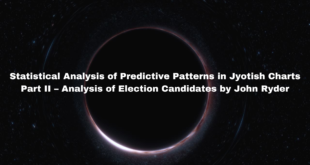Related Articles
Typed & Proof Read By
Swathi Venkata Lakshmi . K
JAIMINI MAHARSHI in his Sutragrantha, after his benedictory sutra, commences with a novel exposition of the aspects in three sutras. The use of this novel concept of the aspects is shown next in another new item of argala, in six sutras and the application is sporadically indicated in two sutras(Adh.1,Pada 3,22,23).
Although the sage expends altogether eight sutras for a single item of argala, we hardly discern in the Sanskrit commentaries, old or modern , a valid application save prima facie arguments and doctrines, limited to the argala formation. Having made a deep study of how best we could make use of the argala application, in more than two hundred horoscopic charts, I am enthused to present a clear and thorough method of applications before the readers, with my own interpretation of the relevant argala sutras.
Let me begin with the item of aspects, which is the linch-pin of argala.
अभिपश्यन्ति ऋक्षाणि
abhipaśyanti ṛkṣāṇi
पार्श्वभे च
pārśvabhe ca
तन्निष्ठाश्च तद्वत्
tanniṣṭhāśca tadvat
The meaning of the above three sutras is as follows: The signs aspect (look at) their frontal sings. They also aspect their lateral signs. The planets also aspect in the manner the signs they look at. The table given below is useful in the next exposition of the argala application.
I. Argala Sutras and Interpretation
1.दारभाग्यशूलस्थार्गळा निध्यातुः
dārabhāgyaśūlasthārgaḻā nidhyātuḥ
Translation: The 4th (Dara),2nd(Bhagya) and 11th (Soola) signs reckoned from an aspecting planet are the argala signs.
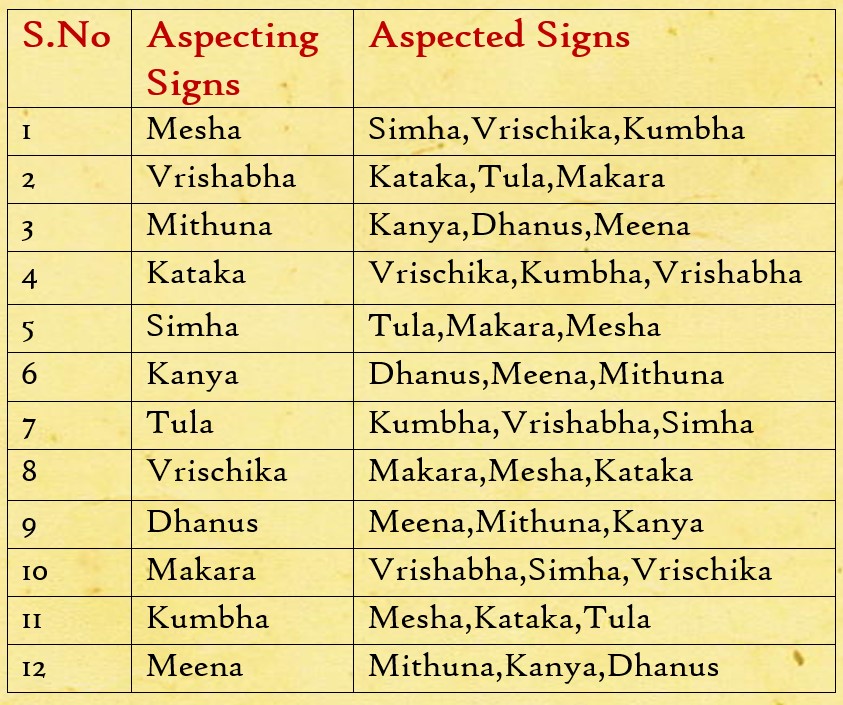
2. कामस्थातुभूयसा पापानाम्
kāmasthātubhūyasā pāpānām
Translation: The 3rd from an aspecting planet, occupied by more than two malefics, is the argala sign.
3. रिःफ नीच कामस्था विरोधिनः
riḥpha nīca kāmasthā virodhinaḥ
Translation: The 10th(Ripha), 12th(Neecha),3rd(Karma) sings are the virodhargala signs respectively of the 4th ,2nd ,11th argala signs.
4. न न्यूना विबलाश्च
na nyūnā vibalāśca
Translation: The argalas by the planets in the 4th, 2nd, and 11th signs will not be obstructed if the 10th,12th ,3rd sings are oc
cupied by less number of planets or by the weaker planets.
5. प्राग्वत् त्रिकोणे
prāgvat trikoṇe
Translation: The trikona(5th,9th) argala signs may be understood as before.
6. विपरीतं केतोः
viparītaṁ ketoḥ
Translation: The contrary holds good in the case of Ketu.
II. Controversial Arguments:
What does prāgvat (as before) mean?
It means that it is like the 2nd sutra kāmasthātubhūyasā pāpānām.
The argala of the 3rd sign occupied by more than two malefics cannot be obstructed (nirabhasargala as understood by the use of tu in the sutra. Similarly the 5th and 9th argala signs do not get obstructed. The above interpretation is inadmissible since pragwat cannot straightaway relate to the 2nd sutra because of the two sutras being in between the 2nd sutra and the 5th pragwat sutra. Hence pragwat trikone means that the 5th sign is the argala sign and the 9th sign is the virodhargala sign.
In such a case, why should the sage enunciate the 5th sutra, pragwat trikone separately? He could have safely inserted a word like, santa(5) in the 1st argala sutra and another word, like , dhatus(9) in the 3rd(virodhargala)sutra.
That is true. But the sage intended that vipareetam ketoh should pertain to its preceding pragwat trikone only. It means that for Ketu, the 9th is the argala sign and the 5th is virodhargala sign. The sage expended the 5th sutra, pragwat trikone to prevent the involvement of Ketu for the argala signs mentioned in the 1st sutra and the 2nd sutra. The sutra ,Vipareetam ketoh may be connected also with the next sutra, Atmadhikah … by the dehali deepaka nyaya. No, it would be tantamount to dishonouring the regular order of the planets from the Sun to Ketu, by first mentioning Ketu in the atmakaraka theory. Thus ran the controversial arguments without deferring to the argala application, nonchalant of the role of the aspecting planet.
III. Valid Application
Here is my interpretation of the valid argala application. The 1st category of the argala signs 2nd,4th,11th is given in the 1st argala sutra. These argala signs have the virodhargala signs viz. 12th,10th , 3rd. The 2nd category is given in the 2nd argala sutra. This 3rd argala sign, occupied by more than two malefics, has no virodhargala sign at all. Thus these two categories differ from each other. The sage next expends one more sutra to enunciate the 3rd category, viz,. trikonargala signs. The sage uses pragwat probably to make us understand this category also, as we understand the other two categories , as mentioned before. Pragwat does not necessarily behave us to understand the similitude of the argala cadres. Now I shall tabulate the three categories.
The point that the 3rd category differs a little from the other two categories is evidenced, when we come to know how the three categories are potential in the formation of the subhargala yogas, analysed below.
2. कामस्थातुभूयसा पापानाम्
kāmasthātubhūyasā pāpānām
Translation: The 3rd from an aspecting planet, occupied by more than two malefics, is the argala sign.
3. रिःफ नीच कामस्था विरोधिनः
riḥpha nīca kāmasthā virodhinaḥ
Translation: The 10th(Ripha), 12th(Neecha),3rd(Karma) sings are the virodhargala signs respectively of the 4th ,2nd ,11th argala signs.
4. न न्यूना विबलाश्च
na nyūnā vibalāśca
Translation: The argalas by the planets in the 4th, 2nd, and 11th signs will not be obstructed if the 10th,12th ,3rd sings are occupied by less number of planets or by the weaker planets.
5. प्राग्वत् त्रिकोणे
prāgvat trikoṇe
Translation: The trikona(5th,9th) argala signs may be understood as before.
6. विपरीतं केतोः
viparītaṁ ketoḥ
Translation: The contrary holds good in the case of Ketu.
II. Controversial Arguments:
What does prāgvat (as before) mean?
It means that it is like the 2nd sutra kāmasthātubhūyasā pāpānām.
The argala of the 3rd sign occupied by more than two malefics cannot be obstructed (nirabhasargala as understood by the use of tu in the sutra. Similarly the 5th and 9th argala signs do not get obstructed. The above interpretation is inadmissible since pragwat cannot straightaway relate to the 2nd sutra because of the two sutras being in between the 2nd sutra and the 5th pragwat sutra. Hence pragwat trikone means that the 5th sign is the argala sign and the 9th sign is the virodhargala sign.
In such a case, why should the sage enunciate the 5th sutra, pragwat trikone separately? He could have safely inserted a word like, santa(5) in the 1st argala sutra and another word, like , dhatus(9) in the 3rd(virodhargala)sutra.
That is true. But the sage intended that vipareetam ketoh should pertain to its preceding pragwat trikone only. It means that for Ketu, the 9th is the argala sign and the 5th is virodhargala sign. The sage expended the 5th sutra, pragwat trikone to prevent the involvement of Ketu for the argala signs mentioned in the 1st sutra and the 2nd sutra. The sutra ,Vipareetam ketoh may be connected also with the next sutra, Atmadhikah … by the dehali deepaka nyaya. No, it would be tantamount to dishonouring the regular order of the planets from the Sun to Ketu, by first mentioning Ketu in the atmakaraka theory. Thus ran the controversial arguments without deferring to the argala application, nonchalant of the role of the aspecting planet.
III. Valid Application
Here is my interpretation of the valid argala application. The 1st category of the argala signs 2nd,4th,11th is given in the 1st argala sutra. These argala signs have the virodhargala signs viz. 12th,10th , 3rd. The 2nd category is given in the 2nd argala sutra. This 3rd argala sign, occupied by more than two malefics, has no virodhargala sign at all. Thus these two categories differ from each other. The sage next expends one more sutra to enunciate the 3rd category, viz,. trikonargala signs. The sage uses pragwat probably to make us understand this category also, as we understand the other two categories , as mentioned before. Pragwat does not necessarily behave us to understand the similitude of the argala cadres. Now I shall tabulate the three categories.
The point that the 3rd category differs a little from the other two categories is evidenced, when we come to know how the three categories are potential in the formation of the subhargala yogas, analysed below.

IV . Subhargala Yogas:
1. The planets irrespective of the benefics or the malefics, occupying the 2nd,4th ,11th signs (PAS) can form the subhargala yogas when the virodhargala signs, 12th,10th ,3rd lie vacant.
It means that if both the A.S. and V.A.S are occupied by the planets , the argala , formed, is only aabhaasa, doing no good. However a concession is given. If the number of the planets in the V.A.S is less than those in the A.S ., or if the planets in V.A.S are weaker than those in the A.S., the subhargala does not get marred.
2. If the 3rd sign is occupied by more than two malefics or if a malefic among planets in the 3rd sign gets more degrees etc, than the rest of the planets get, a nirabhasargala yoga forms.
3. If the 5th sign is occupied only by the benefics, while the 9th sign lies vacant, a subhargala yoga forms. Similarly if the 9th sign is occupied only by the benefics, while the 5th sign lies vacant, a subhargala yoga forms. However a concession is given to a malefic, if exalted in the formation of the subhargala yoga. Thus the three different categories of the argala signs are involved differently in the formation of the subhargala yogas, one by both the benefics and malefics, the other by malefics only, the 3rd by benefics only.
N.B: Here are two points worth remembering:
1. Rahu / Ketu in the argala signs does not contribute to the formation of the subhargala yogas.
2. The argala signs should be reckoned from an aspecting planet.
Before I deal the aspecting planet that has a vital function in the classification of the subhargala yogas, I offer my interpretation of the 6th argala sutra “viparītaṁ ketoḥ”.
That the argala signs should be reckoned from the aspecting planet is evident in the very 1st argala sutra; by the word nidhyatuhu. The exposition of argala closes with the 6th argala sutra “viparītaṁ ketoḥ” specifying Ketu. The subhargala yogas are deduced by all the three categories of the argala signs , connected with any aspecting planet in general. But with regard to Ketu, the contrary holds good. It means that if Ketu is involved with the aspecting planets, in the formation of the subhargala yoga, the contrary holds good. It means that if Ketu is involved with the aspecting planets, in the formation of the subhargala yoga, the contrary of the subhargala yoga holds good. It means Ketu spoils the subhargala. By the mention of Ketu in the sutra, Rahu also comes into picture, though in fact, Rahu is more destructive than Ketu.
V. Aspecting Planets:
I have conveniently classified the aspecting planets into six kinds according to their potentiality in the formation of the subhargala yogas. I enumerate below from the lowest to the highest.
1. A planet who aspects Janma Lagna
2. A planet who aspects both Janma Lagna and its 7th house.
3. The lord of the sign occupied by the Moon aspecting Janma Lagna called Kevala.
4. The lord of the sign occupied by the Moon aspecting both the Moon and Janma Lagna called Yogada.
5. A planet aspecting Janma Lagna is Rasi chart and Navamsa Lagna in Navamsa chart called Yogada.
Or
A planet aspecting Janma Lagna in Rasi chart and Drekkana Lagna in Drekkana chart called Yogada.
6. A planet aspecting Janma Lagna in Rasi chart, Navamsa Lagna in Navamsa chart and Drekkana Lagna in Drekkana chart.
The sage has hinted the use of the argala exposition in the 22nd and 23rd sutras in the 3rd pada of the 1st adhyaya. They are:
पत्नीमाभयोः दिष्ट्या निराभासार्गलया
patnīmābhayoḥ diṣṭyā nirābhāsārgalayā
This relates to the 1st category of the argala sings(P.A.S) connected with the 2nd order of the aspecting planets , enumerated above.
शुभार्गळे धनसमृद्धिः
śubhārgaḻe dhanasamṛddhiḥ
This relates to the 3rd order of the argala signs 7 (S.A.S.) connected with the 2nd order of the aspecting planets. In the 1st case, the involvement of both benefics and malefics in the P.A.S. is allowed. This subhargala yoga , so formed, without obstruction, bestows prosperity. In the 2nd case, the involvement of only the benefics is allowed. This subhargala yoga, so formed, with out obstruction by the planets in the corresponding V.A.S., gives enough money . Here also lies an inapplicable debate without reference to the A.P.
Assessment of Subhargala Potential
1. Assess the subhargala – potential by the six orders of the aspecting planet, the 1st being the lowest and the 6th being the highest.
2. Assess the subhagala – potential by the merits and demerits of the aspecting planet.
Merits:
1. Exaltation or own house position of the aspecting planet.
2. Association of the Moon with the aspecting planet.
3. Aspect or association of the exalted planets with the aspecting planet.
Demerits:
1. The subhargala – potential falls if Rahu is associated with the aspecting planet. Rahu destroys the subhargala yoga like a droplet of poison in a pot of milk.
2. The subhargala potential decreases much by the association of Ketu with the aspecting planet.
3. The subhargala – potential decreases if the aspecting planet is debilitated.
4. Rahu in the 5th or 9th from the aspecting planet reduces the subhargala – potential .
5. Rahu in the 8th and 12th also from the aspecting planet is not a welcome feature.
The subhargala-potential can also be classified into three orders viz., superior, above-average, average, according to the planets and the argala signs involved in the formation of the subhargala yogas.
Superior Order:
1. Involvement of the benefics in the argala signs;
2. Involvement of three planets in the argala signs.
3. Involvement of the planets in the three argala signs.
Above – average order :
1. Involvement of both benefics and malefics in the argala signs
2. Involvment of two planets in the argala signs;3.Involvement of the planets in any two argala signs.
Average Order :
1. Involvement of malefics in the argala sign
2. Involvement of one planet in the argala sign.
Reckoning Principles
1. Reckon the argala signs in the regular order from the aspecting planet.
2. Judge also the subhargala yogas, if formed by the reverse reckoning of the argala signs from the aspecting planet posited in an even sign.
Results of subhargala yoga in general are good position in life , financial status and reputation. Benefits give very sound financial position. Both benefics and malefics indicate the unsteady financial status. Malefics indicate the average position. Other results also may be assessed similarly.
Abbreviations : J.L = Janma Lagna ; N.L.=Navamsa Lagna; D.L.=Drekkana Lagna; A.P.= Aspecting Planet ; A.S.=Argala Sign; V.A.S.=Virodhargala Sign; P.A.S.=Primary Argala Sign; Sp.A.S=Specific Argala Sign; S.A.S.=Secondary Argala Sign; S.A.Y= Subhargala Yoga; S.A.P.=Subhargala Potential.
Illustrations :
Chart 1: DOB. = Dr. B.V. Raman, 8.8.1912, 19:38 Hrs

In Chart 1, J.L. is Kumbha. The Sun in Kataka aspects J.L.Kumbha. Hence the Sun is A.P.-1. Reckoned from the Sun, the 2nd P.A.S. is occupied by Mars, Mercury and Venus, the 5th S.A.S. is occupied by Jupiter, and the 11th P.A.S. is occupied by the Moon and Saturn. The V.A.S. of the above lie absolutely vacant. Hence the S.A.Y. is formed. The involvement of 3 A.S. and 6 planets is a rare phenomenon in the formation of S.A.Y. Hence the S.A.P. rises far above the superior order as against the lowest order of the aspecting planet, Sun. That is why the native gradually rose to a high and a unique position in the field of Astrology, though he did not secure any high covetable post of power in the private or government concern. Jupiter in the 5th S.A.S. in the S.A.Y. of high S.A.P. is a key planet for his world-repute as a doyen of the 20th century astrologers and as a learned author of innumerable books on astrology, and as the renowned Editor of THE ASTROLOGICAL MAGAZINE.
Chart 2: DOB. 14-2-1936 at 7.25 a.m.
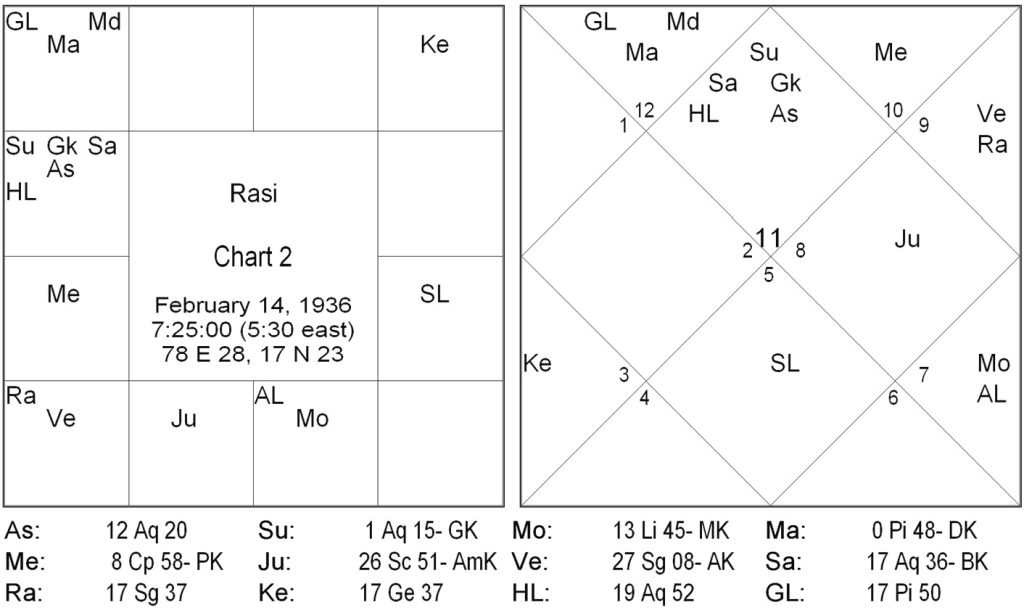
In Chart 2, J.L. is Kumbha. The Moon aspects both J.L. and its 7th house. Hence the Moon is the A.P.-2. From the Moon the 2nd P.A.S. is occupied by Jupiter and the 4th P.A.S. is occupied by Mercury. The corresponding V.A.S. lie vacant. Hence the S.A.Y. formed belongs to the above average S.A.P. The native is a professor in medicine and his financial position is sound. He has only two sons, one is a doctor and the other is an engineer. Both have married rich girls.
Chart 3. D.B.31-12-1962 at 3.02 p.m.

In Chart 3, J.L. is Vrishibha . The lord of the sign occupied by the Moon is Saturn who is posited in his own house, Makara. Saturn aspects both J.L. and its 7th house. Hence Saturn becomes the Kevala belonging to the A.P.-3. From Saturn ,the 2nd P.A.S. is occupied by the Moon and Jupiter and the 11th P.A.S. is occupied by Venus. So 2 A.S. and 3 benefics are involved in the formation of the S.A.Y. The S.A.P. may be considered of the superior order , in addition to the 3rd higher order of the aspecting planet. The native of Chart 3 is M.B.B.S., D.C.H. and shares the wealth earned by his father, the native of Chart 2. The native married a rich girl who is studying medicine. And she is the only daughter of a well positioned and wealthy father. The native is likely to set up practice.
Chart 4 : DOB.21-5-1927 at 6.30 p.m.
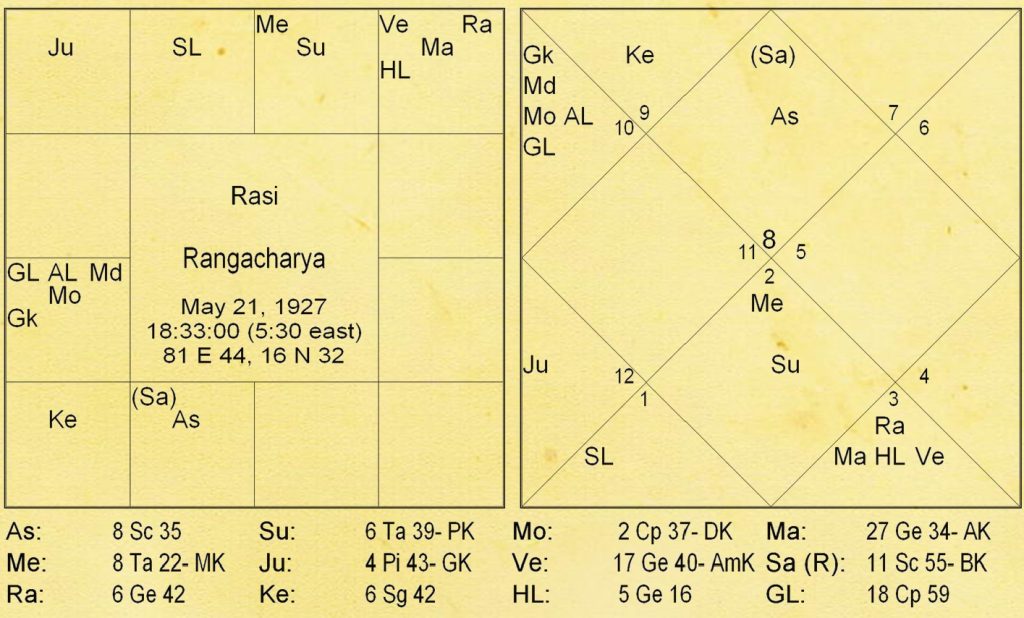
In Chart 4, J.L. is Vrischika. The lord of the sign occupied by the Moon is Saturn who occupies J.L., aspecting the Moon. Hence Saturn becomes Yogada belonging to the A.P.-4. Reckoned from Saturn, the 5th S.A.S. is occupied by the benefic Jupiter. The S.A.P. is of the average order because one sign and one planet are involved , while the A.P. belongs to the 4th higher order. By the reverse reckoning from Saturn, two A.S.(11th & 5th) and two planets are involved in the formation of the S.A.Y. However the S.A.P. can be considered as just above average. In this case the role of Jupiter in the S.A.S well placed in own house is more significant as a result of which the native is known for his knowledge in Jaimini Astrology and for his Sanskrit poetry.
Chart 5: DOB. 31-12-1915 at 7.44p.m.

In Chart 5,J.L is Karakataka. Venus aspects J.L. in Rasi chart and N.L. in Navamsa chart. Hence Venus is the Yogada of A.P.-5. From Venus the 5th S.A.S is occupied by the benefic Jupiter and the 11th P.A.S. is occupied by Mercury and the Moon. 2. A.S. and 3 planets are involved in the formation of the S.A.Y. The S.A.P. is of above-average order, though the benefic Mercury is debilitated. The plus point is the occupancy of Jupiter in the 5th S.A.S. despite Jupiter’s inimical placement. Besides sound financial position, the native is a veteran astrologer of long experience and is k known to have special interest in the Ashtakavarga theory.
Chart 6: D.B.19-1-1947 at 4.05 p.m., Ascendant. 2” 12˚ 08’ and Moon 8” 3˚ 39’.
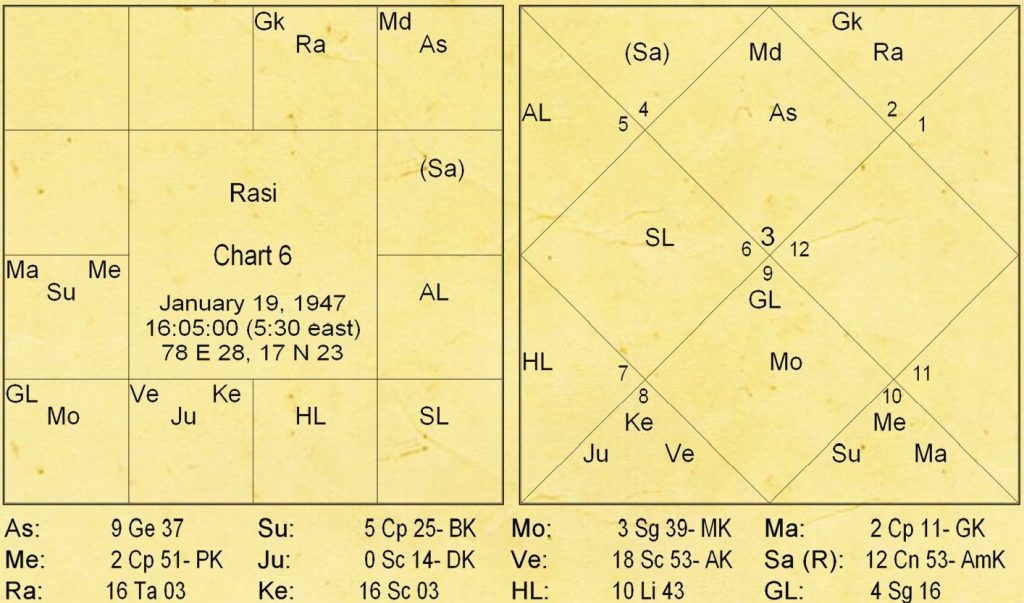
In Chart 6,J.L is Mithuna. The moon aspects J.L in Rasi chart , N.L. in Navamsa chart and D.L in Drekkana chart. Hence the Moon becomes the Yogada belonging to the highest order of the aspecting planet (A.P.6) . Reckoned from the Moon, the 2nd P.A.S. is occupied by three malefics, while the 12th V.A.S. is occupied by three planets, causing the aabhasargala. However , since Mars is exalted in the 2nd P.A.S., S.A.Y. still exists. The S.A.P. is of average order since one planet (exalted Mars) and one sign are left in the formation of the S.A.Y. In total by the A.P.6 also , the S.A.P. can be considered as above average. The native is a professor in mathematics and is an all-rounder. He has exhibited his histrionic talents on several occasions, but an offer from cine-field was lost.
Chart 7 :D.B. 29-6-1946 at 8 p.m. Ascendant L 9” 3˚ 42’ Mars 4” 12˚ 10’.

In Chart 7 , J.L is Makara. Mars aspects J.L. in Rasi chart, N.L. in Navamsa chart and D.L. in Drekkana chart. Hence Mars becomes the Yogada belonging to the highest order of the aspecting planet (A.P.6). From Mars, the 11th P.A.S. is occupied by the Sun and the Moon. One A.S. and two planets are involved in the formation of the S.A.Y. The S.A.P. is average .But by the order of A.P.6 also, the sum total of S.A.P. can be considered as superior. The native is now in a high post of a Senior Manager in a Central Public Sector undertaking under the Ministry of Steel and Mines. He has visited many foreign countries. There are clear prospects for his further elevation . He has great histrionic talents. He too missed an opportunity in the cine-field which can fetch one fabulous money. Note the 11th P.A.S. is occupied by two malefics viz., the Sun and the Moon, not so indicative of fabulous wealth.
The next most interesting item of the argala exposition is the classification of the argala rajayogas.
Learn Astrology: Join Our Upcoming Astrology Classes — Click Here
Learn Astrology: Join Our Recorded Astrology Classes — Click Here
 Saptarishis Astrology Magazine Into Creating Astrologers
Saptarishis Astrology Magazine Into Creating Astrologers


